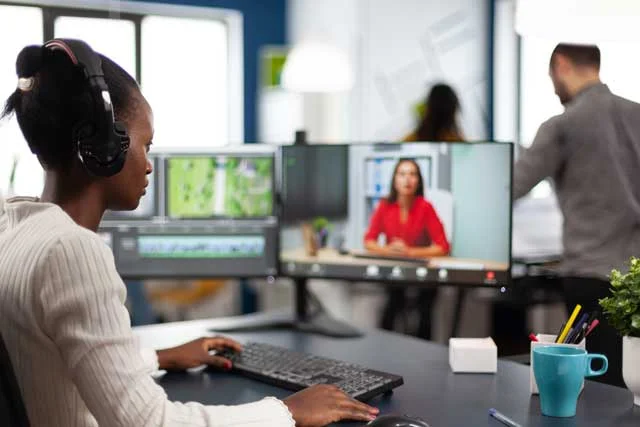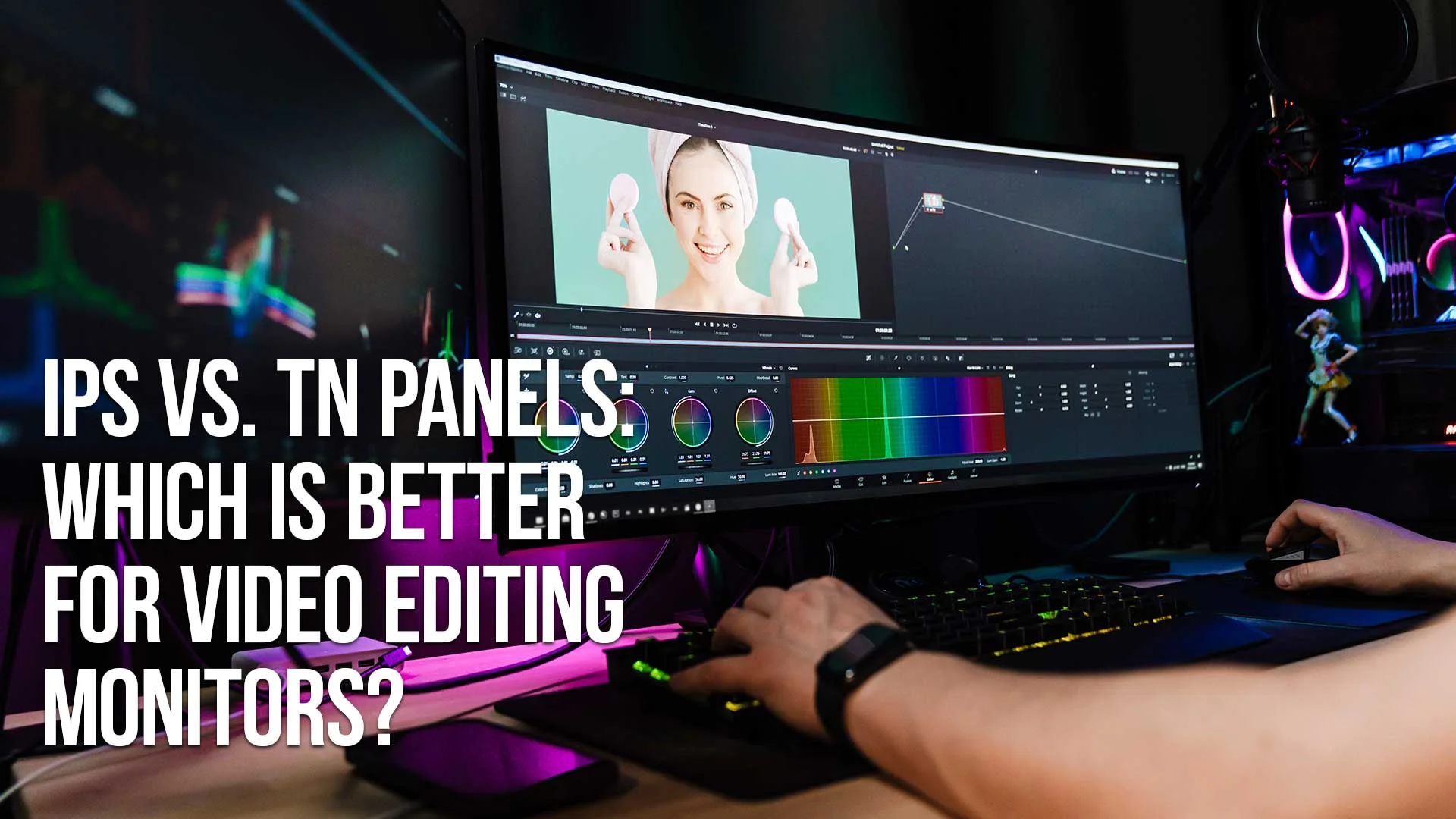Parent Article: The Best Monitors for Video Editing
When it comes to video editing, having the right monitor can make all the difference.
The two most popular types of monitors are In-Plane Switching (IPS) and Twisted Nematic (TN) panels.
Both have their pros and cons, and it can be challenging to decide which one is better suited for your needs.
In this article, we will explore the differences between IPS and TN panels, and which one is better for video editing monitors.

What is an IPS Panel?
IPS panels are known for their excellent color accuracy and wider viewing angles. They are typically more expensive than TN panels, but they offer superior image quality.
IPS panels are ideal for color-critical applications such as graphic design, video editing, and photography.
IPS panels work by aligning liquid crystals in a plane parallel to the screen, which allows light to pass through without distortion.
This results in more accurate color reproduction and better contrast, making them perfect for tasks where color accuracy is essential.
What is a TN Panel?
TN panels are known for their fast response times and low input lag, making them ideal for gaming and fast-paced applications. They are also less expensive than IPS panels, making them a popular choice for budget-minded users.
TN panels work by twisting liquid crystals to adjust the amount of light that passes through.
While this technology allows for faster response times, it also results in narrower viewing angles and inferior color accuracy compared to IPS panels.

Which Panel is Better for Video Editing Monitors?
When it comes to video editing, IPS panels are generally considered the better choice.
Their superior color accuracy and wider viewing angles make them ideal for tasks that require precise color reproduction.
TN panels, on the other hand, are better suited for applications that require fast response times and low input lag, such as gaming.
One of the biggest advantages of IPS panels for video editing is their ability to display a broader range of colors.
IPS panels can typically display up to 10 bits of color depth, which translates to over a billion colors. This makes them ideal for color-critical applications such as video editing.
Another advantage of IPS panels is their wider viewing angles.
With an IPS panel, you can view the screen from virtually any angle without experiencing color distortion or contrast loss. This is particularly useful in a collaborative work environment where multiple people need to view the same screen.
IPS vs. TN Panel Comparison Table
To help you better understand the differences between IPS and TN panels, we've created a comparison table below.
| Feature | IPS Panel | TN Panel |
|---|---|---|
| Color Accuracy | Excellent | Good |
| Viewing Angles | Wide | Narrow |
| Response Time | Slower | Faster |
| Input Lag | Higher | Lower |
| Price | More Expensive | Less Expensive |
| Applications | Color-critical applications | Fast-paced applications (e.g., gaming) |

Factors to Consider When Choosing a Video Editing Monitor
When choosing a video editing monitor, there are several factors to consider, including:
Color Accuracy
Color accuracy is arguably the most critical factor when it comes to video editing. You want a monitor that can display colors as accurately as possible to ensure your work looks as intended. IPS panels are generally considered to be the best option for color-critical applications.
Resolution
Resolution refers to the number of pixels on the screen. The higher the resolution, the sharper and more detailed the image will be. For video editing, we recommend choosing a monitor with at least a 1440p resolution.
Size
The size of the monitor is also an important factor to consider. A larger monitor can be beneficial for video editing as it allows you to see more details and work with multiple windows or applications simultaneously. However, a larger monitor also takes up more desk space and can be more expensive.
Panel Type
As we've discussed, the panel type is a crucial factor to consider when choosing a video editing monitor. IPS panels are generally better suited for color-critical applications, while TN panels are better for fast-paced applications such as gaming.
Refresh Rate
The refresh rate refers to how many times per second the monitor can refresh the image on the screen. A higher refresh rate can result in smoother visuals, which can be beneficial for video editing. However, it's important to note that a higher refresh rate may also come with a higher price tag.
Price
Of course, price is always a factor to consider when choosing any type of monitor. IPS panels are typically more expensive than TN panels, but they also offer better color accuracy and wider viewing angles.
IPS vs. TN Frequently Asked Questions
Can I use a TN panel for video editing?
While it's possible to use a TN panel for video editing, we generally don't recommend it. TN panels have inferior color accuracy and narrower viewing angles compared to IPS panels, which can make it more difficult to achieve accurate color reproduction.
What is the best resolution for video editing?
We recommend choosing a monitor with at least a 1440p resolution for video editing. This will ensure that you have enough screen real estate to work with multiple windows or applications simultaneously while still providing a sharp, detailed image.
Can I use a gaming monitor for video editing?
While gaming monitors can be used for video editing, they may not be the best option. Gaming monitors typically prioritize fast response times and high refresh rates over color accuracy and viewing angles, which are essential for video editing.
How important is color accuracy for video editing?
Color accuracy is crucial for video editing as it ensures that your work looks as intended across different devices and platforms. IPS panels are generally considered to be the best option for color-critical applications such as video editing.
Is a larger monitor better for video editing?
A larger monitor can be beneficial for video editing as it allows you to see more details and work with multiple windows or applications simultaneously. However, a larger monitor also takes up more desk space and can be more expensive.
What is the difference between a 60Hz and 144Hz monitor?
The refresh rate refers to how many times per second the monitor can refresh the image on the screen. A 60Hz monitor can refresh the image 60 times per second, while a 144Hz monitor can refresh the image 144 times per second. A higher refresh rate can result in smoother visuals, which can be beneficial for video editing.
Are IPS panels more expensive than TN panels?
Yes, IPS panels are generally more expensive than TN panels. This is due to the superior color accuracy and wider viewing angles that IPS panels offer.
Can multiple people view an IPS panel without experiencing color distortion or contrast loss?
Yes, one of the advantages of IPS panels is their wider viewing angles. With an IPS panel, you can view the screen from virtually any angle without experiencing color distortion or contrast loss. This is particularly useful in a collaborative work environment where multiple people need to view the same screen.
What is input lag?
Input lag refers to the delay between when you input a command on your keyboard or mouse and when that command is registered on the screen. A lower input lag can result in faster response times, which can be beneficial for fast-paced applications such as gaming.
Are there any downsides to using an IPS panel for video editing?
While IPS panels offer superior color accuracy and wider viewing angles, they do have some downsides. One of the biggest disadvantages of IPS panels is their slower response times compared to TN panels. This can result in motion blur or ghosting in fast-paced scenes. Additionally, IPS panels are typically more expensive than TN panels, which may be a consideration for budget-minded users. However, for color-critical applications such as video editing, the benefits of IPS panels often outweigh these downsides.
Conclusion
When it comes to video editing monitors, choosing between IPS and TN panels can be a challenging decision.
IPS panels offer superior color accuracy and wider viewing angles, making them ideal for color-critical applications such as video editing.
TN panels, on the other hand, are better suited for fast-paced applications such as gaming, thanks to their fast response times and low input lag.
Ultimately, the choice between IPS and TN panels will depend on your specific needs and budget.
If color accuracy is essential for your work, an IPS panel is the better choice.
However, if you prioritize fast response times and low input lag, a TN panel may be more suitable.
By considering the factors we've discussed in this article, you can make an informed decision and choose the best video editing monitor for your needs.
Video Monitors Related Posts
The Best Monitors Compatible with MacBook Pro
Best Monitors for Video Editing
Understanding Monitor Resolution and Its Impact on Video Editing
Calibrating Your Video Editing Monitor for Optimal Color Accuracy
The Benefits of Dual-Monitor Setups for Video Editing
Future-Proofing Your Video Editing Setup: Choosing a Monitor with Upgrade Potential
Minimizing Eye Strain and Fatigue with the Right Video Editing Monitor
How to Choose the Right Video Editing Monitor for Your Needs
What to Look for in HDR-Capable Video Editing Monitors
The Importance of Color Accuracy in Video Editing Monitors
IPS vs. TN Panels: Which is Better for Video Editing Monitors?
Video Editing Related Posts
Adobe Creative Cloud for Video Editing
Top 10 Video Editing Software for Mac
The Benefits of Dual-Monitor Setups for Video Editing
How to Choose the Right Video Editing Monitor for Your Needs
Best Monitors for Video Editing
Best Video Editing Software in 2023
Best Mac for Video Editing in 2023
(Almost) 50 Mistakes Every New Video Producer Makes
Breakthrough AI Tools: Elevate Your Video Production Game!
Table of Contents
- What Is An IPS Panel?
- What Is A TN Panel?
- Which Panel Is Better For Video Editing Monitors?
- IPS Vs. TN Panel Comparison Table
- Factors To Consider When Choosing A Video Editing Monitor
- Color Accuracy
- Resolution
- Size
- Panel Type
- Refresh Rate
- Price
- IPS Vs. TN FAQ
Video Monitors Related Posts
The Best Monitors Compatible with MacBook Pro
Best Monitors for Video Editing
Understanding Monitor Resolution and Its Impact on Video Editing
Calibrating Your Video Editing Monitor for Optimal Color Accuracy
The Benefits of Dual-Monitor Setups for Video Editing
Future-Proofing Your Video Editing Setup: Choosing a Monitor with Upgrade Potential
Minimizing Eye Strain and Fatigue with the Right Video Editing Monitor
How to Choose the Right Video Editing Monitor for Your Needs
What to Look for in HDR-Capable Video Editing Monitors
The Importance of Color Accuracy in Video Editing Monitors
IPS vs. TN Panels: Which is Better for Video Editing Monitors?
Video Editing Related Posts
Adobe Creative Cloud for Video Editing
Top 10 Video Editing Software for Mac
The Benefits of Dual-Monitor Setups for Video Editing
How to Choose the Right Video Editing Monitor for Your Needs
Best Monitors for Video Editing
Best Video Editing Software in 2023
Best Mac for Video Editing in 2023
(Almost) 50 Mistakes Every New Video Producer Makes
Breakthrough AI Tools: Elevate Your Video Production Game!
